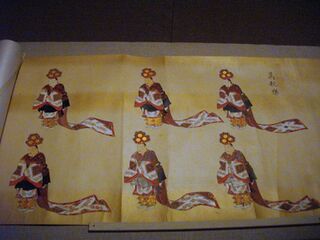Difference between revisions of "Bugaku"
(Created page with "*''Japanese'': 舞楽 ''(bugaku)'' ''Bugaku'' is a classical Japanese form of Imperial court dance. Like ''gagaku'' court music, which is divided into Chinese- and Korea...") |
|||
| Line 1: | Line 1: | ||
| + | [[File:Bugaku-scroll.jpg|right|thumb|320px|A scroll painting of various ''bugaku'' dances, 17th century. Metropolitan Museum of Art]] | ||
*''Japanese'': 舞楽 ''(bugaku)'' | *''Japanese'': 舞楽 ''(bugaku)'' | ||
| − | ''Bugaku'' is a classical Japanese form of Imperial court dance. | + | ''Bugaku'' is a classical Japanese form of Imperial court dance, closely associated with ''[[gagaku]]'' court music. It is derived from a combination of [[Shinto]] dance and Chinese, Korean, and Southeast Asian influences, and developed into its mature form largely in the 8th-9th centuries. |
| − | Like '' | + | Like ''gagaku'' court music, which is divided into Chinese- and Korean-derived forms (''Tôgaku'' and ''Komagaku''), ''bugaku'' is divided into three categories: ''kuniburi-no-mai'' (native Japanese dances), ''Sa-no-mai'' (dances of the left, derived from those of the [[Tang Dynasty]] first introduced in [[698]]), and ''U-no-mai'' (dances of the right, derived from those of Korea). The Chinese-style dances typically use red costumes, while the Korean-style ones use green costumes. Performers included both [[kuge|court nobles]] and hereditary guilds of court entertainers, and ''bugaku'' continued through to the modern era. |
The Chinese-style dances are typically accompanied by three types of flutes (''[[hichiriki]]'', ''[[ryuteki|ryûteki]]'', and ''[[sho|shô]]'') and percussion instruments such as the ''[[kakko]]'', ''[[shoko|shôko]]'', and ''[[taiko]]'', without string instruments. The Korean-style dances, the ''shô'' and ''ryûteki'' are replaced by the Korean-style flute (''[[komabue]]''), and the ''san-no-tsuzumi'' instead of ''kakko''. | The Chinese-style dances are typically accompanied by three types of flutes (''[[hichiriki]]'', ''[[ryuteki|ryûteki]]'', and ''[[sho|shô]]'') and percussion instruments such as the ''[[kakko]]'', ''[[shoko|shôko]]'', and ''[[taiko]]'', without string instruments. The Korean-style dances, the ''shô'' and ''ryûteki'' are replaced by the Korean-style flute (''[[komabue]]''), and the ''san-no-tsuzumi'' instead of ''kakko''. | ||
| Line 11: | Line 12: | ||
==References== | ==References== | ||
*Gallery labels, [[Tokyo Imperial Palace]].[https://www.flickr.com/photos/toranosuke/18200814551/sizes/k/] | *Gallery labels, [[Tokyo Imperial Palace]].[https://www.flickr.com/photos/toranosuke/18200814551/sizes/k/] | ||
| + | *Gallery label, "Bugaku Scroll," Metropolitan Museum of Art, 57.52.1.[https://www.flickr.com/photos/toranosuke/3298209948/sizes/l] | ||
[[Category:Nara Period]] | [[Category:Nara Period]] | ||
| − | [[Category:Poetry and | + | [[Category:Poetry and Theater]] |
Revision as of 23:39, 6 June 2015
- Japanese: 舞楽 (bugaku)
Bugaku is a classical Japanese form of Imperial court dance, closely associated with gagaku court music. It is derived from a combination of Shinto dance and Chinese, Korean, and Southeast Asian influences, and developed into its mature form largely in the 8th-9th centuries.
Like gagaku court music, which is divided into Chinese- and Korean-derived forms (Tôgaku and Komagaku), bugaku is divided into three categories: kuniburi-no-mai (native Japanese dances), Sa-no-mai (dances of the left, derived from those of the Tang Dynasty first introduced in 698), and U-no-mai (dances of the right, derived from those of Korea). The Chinese-style dances typically use red costumes, while the Korean-style ones use green costumes. Performers included both court nobles and hereditary guilds of court entertainers, and bugaku continued through to the modern era.
The Chinese-style dances are typically accompanied by three types of flutes (hichiriki, ryûteki, and shô) and percussion instruments such as the kakko, shôko, and taiko, without string instruments. The Korean-style dances, the shô and ryûteki are replaced by the Korean-style flute (komabue), and the san-no-tsuzumi instead of kakko.
References
- Gallery labels, Tokyo Imperial Palace.[1]
- Gallery label, "Bugaku Scroll," Metropolitan Museum of Art, 57.52.1.[2]
